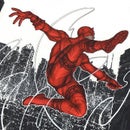Introduction: Bias Tape Tutorial - Endings
You've made it to the end of your bias tape. This tutorial will show you what to do now that you're there!
Step 1: NO!
Let's look first at what I usually see people do, which is often some variation of this. I think people get to the end, go "?????" and then try to flip it to the inside, with varying degrees of success. The back side will ALWAYS try to escape, and getting it to end exactly where your fabric does is pretty much impossible.
Step 2:
There'll also be this ugly gaping hole in the bottom.
Most of the time people will:
A) ignore this
B) stitch across it like a maniac (<---what I used to do)
C) glue it (<---okay I'm guilty of this one too)
D) hand stitch it closed (<---why D:)
A and B look bad, and you'll either have drying time (fabric glue) or potentially melty bits (hot glue) with C. There no point in doing D, because if you are that concerned about it looking good, you should save yourself time (as well as get a far cleaner finish) by doing it with your sewing machine.
Step 3:
If your garment is lined, you should stitch the fabric and lining together along the edge first so that they don't slip around while you're trying to attach your bias tape. (This is the red line of stitching in the photo.) It's ok if the edges are raw, because they will be covered by the bias tape soon.
Step 4:
Here we have our fabric and our bias tape.
Step 5:
Lay your tape out, and stitch exactly to the edge of the fabric. Try not to go over the edge. Make sure to back stitch!
Step 6:
Now flip your tape over like so.
Step 7:
It'll look like this from the side.
Step 8:
Now take the top of your tape, and fold it down over top of your fabric edge, forming a tasty fabric sandwich.
Step 9:
It looks like this from the side. Pin it in place.
Step 10:
Now what you are going to do is to flip the whole thing over. (I
have moved the pins over to the back side of the fabric.)
What's the difference between the back and the front? Well, not much...except that you can see your previous line of stitching on this side, which will come in handy here in a second.
Step 11:
Stitch across the end of the tape, making sure not to catch your garment fabric in your stitching. The closer you can get to it without actually catching it, the better. If your fabric is very thick, using a zipper foot will help you get nice and close to the edge. You can also use a hammer to flatten the fabric fibers before stitching.
Step 12:
Yay! It's stitched.
Step 13:
As you can see, the previous line of stitching will help you judge how
close you can get to things. The more precise you are, the better it will look!
Step 14:
Trim your seam allowance.
Step 15:
Use your adorable point turner (or similarly pointy device) to poke the corner into submission. Flip everything to the inside.
Step 16:
Now it will look like this on the front...
Step 17:
And like this on the back! You can secure the back in whatever manner you prefer. (slipstitch it to the lining, topstitch it, etc)
Step 18:
....and like this on the side. It'll be more or less invisible when you use matching thread.

Participated in the
Crafting 101













